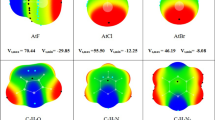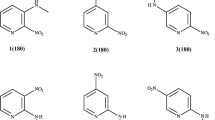Abstract
A semi-empirical LCAO calculation including a- and π-electrons has been performed for pyridine and related heterocyclics. The diagonal matrix elements of Hamiltonian are evaluated from atomic spectroscopic data through the use of a formula derived from the SCF equations. The non-diagonal matrix elements are estimated through the Wolfsberg-Helmholz formula. All overlap integrals have been included. The results disagree with what one can expect from aπ-electron treatment, mainly with respect to population analysis, but they seem strongly supported by the conclusions of “ab initio” calculations for other compounds and the trend of dipole moment in the sequence pyridine, quinoline, acridine.
Zusammenfassung
L'ensemble des systèmes électroniquesσ etπ de la pyridine et de ses homoogues supérieurs a été étudiée par une méthode LCAO semi-empirique. Les élements de matrice diagonaux de l'hamiltonien sont évalués à partir de données de spectroscopie atomique, en faisant appel à une formule dérivée des équations du champ self-consistant. Les éléments de matrice non diagonaux sont calculés par la formule de Wolfsberg-Helmholz. Toutes les intégrales de recouvrement ont été introduites. Surtout en ce qui concerne l'analyse de population, les résultats sont en désaccord avec ce que l'on peut attendre d'un calcul limité au système d'électronsπ; par ailleurs, ils paraissent confirmés par les conclusions de calculs “ab initio” relatifs à d'autres composés et par l'évolution du moment dipolaire dans la série pyridine, quinoléine, acridine.
Resume
Für Pyridin und verwandte Heterozyklen wurde eine LCAO-Rechnung mitσ undπ-Elektronen durchgeführt. Die Diagonalelemente des Hamiltonoperators wurden mittels atomspektroskopischer Daten berechnet unter Benutzung einer aus SCF Rechnungen abgeleiteten Formel, die Nicht-Diagonalelemente mit der Wolfsberg-Helmholz-Formel. Alle Überlappungsintegrale wurden berücksichtigt. Die Ergebnisse stimmen mit solchen ausπ-Elektronen-Behandlungen nicht überein (besonders die Dichteverteilung), scheinen aber stark durch “ab initio”-Rechnungen für andere Verbindungen und das Verhalten des Dipolmoments in der Folge Pyridin, Chinolin, Acridin gestützt zu werden.
Similar content being viewed by others
References
Amos, A. T., andG. G. Hall: Molecular Physics4, 25 (1961).
Bak, B., L. Hansen, andJ. Rastrup-Andersen: J. chew. Physics22, 2013 (1954).
Berthier, G., H. Lemaire, A. Rassat etA. Veillard: Theoret. chim. Acta3, 213 (1965).
-,P. Millie, etA. Veillard: J. Chim. Physique.1965, 8.
Berthod, H., etA. Pullman: J. Chim. physique1965, 942.
- Private communication.
Clementi, E., andH. Clementi: J. chem. Physics36, 2824 (1962).
Foster, J. M., andS. F. Boys: Rev. mod. Physics32, 303 (1960).
Hoffmann, R.: J. chem. Physics40, 2745 (1964).
Hulin, M.: Diplôme d'Etudes Superieures, Faculté des Sciences. Paris 1958.
Kato, H., T. Yonezawa, K. Morokuma, andK. Fukui: Bull. chem. Soc. Jap.37, 1710 (1964).
Kier, L. B.: Tetrahedron Letters37, 3273 (1965).
Lucken, E. A. C.: Tetrahedron19, (Suppl. 2) 123 (1963).
Mac Clellan, A. L.: Tables of experimental dipole moments. San Francisco: Freeman 1963.
McLean, A. D.: J. chem. Physics37, 627 (1962).
Moskowitz, J. W., andM. Barnett: J. chem. Physics39, 1557 (1963).
Mulliken, R. S.: J. chem. Physics23, 1833 (1955).
Parr, R. G.: Quantum theory of molecular electronic structure, p. 41 and foll., p. 86. New York: W. A. Benjamin 1963.
Peters, D.: J. chem. Soc.1963, 2015, 4017.
— Tetrahedron19, (Suppl. 2) 140, 143 (1963).
Pilciier, G., andH. A. Skinner: J. Inorg. Nucl. Chem.24, 937 (1962).
Pujol, L., andA. Julg: Tetrahedron21, 717 (1965).
Roothaan, C. C. J.: Rev. mod. Physics23, 69 (1951).
Rüdenberg, K.: J. chem. Physics19, 1433 (1951).
Slater, J. C.: Quantum theory of atomic structure, p. 368 and foll. New York: McGrawHill 1960.
Wolfsberg, M., andL. Helmiiolz: J. chem. Physics20, 837 (1952).
Author information
Authors and Affiliations
Rights and permissions
About this article
Cite this article
Veillard, A., Berthier, G. π-electron approximation in pyridine and related compounds. Theoret. Chim. Acta 4, 347–351 (1966). https://doi.org/10.1007/BF01129649
Received:
Issue Date:
DOI: https://doi.org/10.1007/BF01129649




